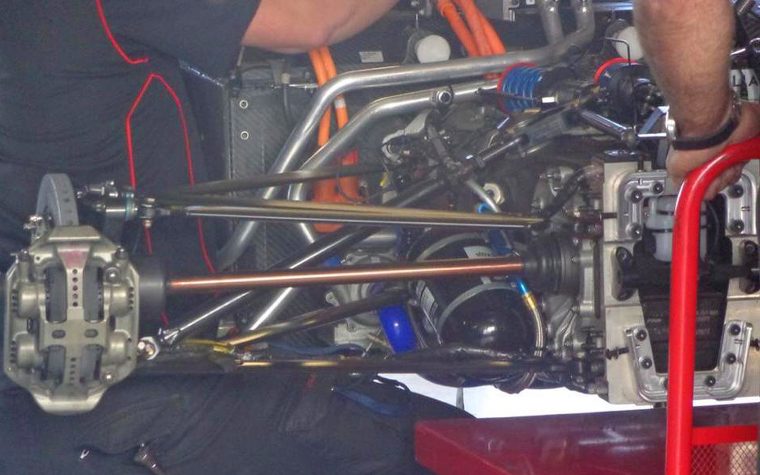Gearbox concepts for season two
[vc_row][vc_column][vc_column_text]
Come season two of the FIA Formula E, the regulations were opened up to allow development as well as R&D.
We have already seen how Formula E engineers are helping the future, as Trulli started off the wireless charging phase, now widely adopted by Samsung for its portable devices. Wireless charging is also used for the BMW i8, the safety car for the series, which just shows the series has a bright future in terms of technology and is really striving forward.
Furthermore, motors have also been re-profiled from season one, to produce more power and have a longer life. One area which is important and will need a lot of R&D is transmissions. To have an efficient concept which is packaged well is by no means easy. Integrating all this with wishbones, dampers and rear crash structure makes for one of the tightest rear-ends in motorsport.
The common trend is whether to have one gear or five? Many ideas have come about in pre-season testing, but what’s best for the gearbox?
Firstly a gearbox is a mechanical device used to transfer energy, in this case, energy from the electric motor to the rear axle. Torque is the power generated through the bending and twisting of a solid material. The gearbox is often used to create a right angle change in direction of power, like bevel gears as seen in a rotary mower or a helicopter. Each unit is made with a specific purpose in mind, and the gear ratio used is designed to provide the level of force required. This ratio is fixed and cannot be changed once the outer casing is constructed. The only possible modification after the fact is an adjustment that allows the shaft speed to increase, along with a corresponding reduction in torque.
For an electric motor, the gearbox will allow the power to be distributed evenly through each gear, although more energy will be used to change the gear (approximately 0.004kw) it will have less strain on the gearbox’s center shaft and gear teeth. You don’t need to have the gearbox in this case, but for the same reason that you have a gearbox in any other normal road or racing car for that matter is to accelerate optimally. Gears can kill the wheel spin from this also, and its the same through long corners – the tyres can spin up thanks to the high levels of torque.
For manual transmission it is available in two different systems: sliding mesh and constant mesh. The sliding mesh system uses straight-cut spur gears. The gears spin freely and require driver manipulation to synchronize the transition from one speed to another. The driver is responsible for coordinating the engine/motor revolutions to the road speed required. If the transition between gears is not timed correctly, they clash, creating a loud grinding noise as the gear teeth hit each other. Lubrication is very important to help combat this. When the car drives past this is of the multi elements that create transmission noise.
The constant mesh system has diagonally-cut helical or double helical gear sets that have been permanently meshed together. Friction comes or synchronised rings have been added to the gears to create a smoother transition when changing gears. This type of transmission is usually found in racing cars, agricultural equipment like tractors and Formula E cars.
The tried and tested Hewland four-speed sequential paddle shift remains the most popular gearbox in the series. For season two Hewland has gone down a gear to four speeds from five, and is to sequential paddle shift. It’s very important that the output shaft or the spline is maintained with a constant speed, as the load on the motor increases, the output speed decreases linearly.
The biggest gain by having one gear is that you will not be out of one, you are still in drive. This means the MGU from the rear axle can harvest that little bit more energy under braking. This philosophy has been adopted by DS and NEXTEV. But what’s interesting is that these two teams are dual motors. The other advantage is that standard driveshafts and differential can be used – which can save weight, and have less to go wrong.
With no gearbox, lots of torque will have to be supplied, which is why two motors have to be used. With one, not enough torque is created from a standing start. With four gears means the driver will have more control on the power output, but fractions of energy are lost when the drive is disconnected. The dice is rolling to who has the best idea. Come the end of the season we will see who exactly got it right.
[/vc_column_text][/vc_column][/vc_row][vc_row][vc_column][vc_column_text]
Image courtesy of Stefan Ruitenberg
[/vc_column_text][/vc_column][/vc_row]





 No part of this website or any of its contents may be reproduced, copied, modified, adapted, used or distributed without the prior written consent of the author. e-racing.net is not responsible for the content of external sites or links.
No part of this website or any of its contents may be reproduced, copied, modified, adapted, used or distributed without the prior written consent of the author. e-racing.net is not responsible for the content of external sites or links.